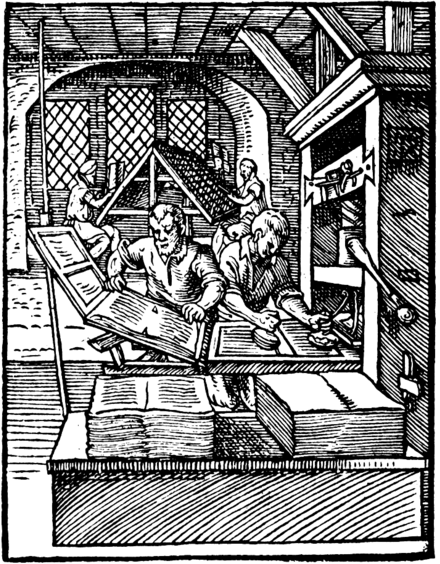Photographic Typesetting
July 21, 2010
In a
previous article (Electronic-Book Readers, July 20, 2010), I wrote about the new
electronic book readers. I was surprised by their history. The earliest such reader, the
Sony Librié, was introduced six years ago. Of course,
Johannes Gutenberg's movable type process was invented in the period 1436-1450, so mass-produced books have been published for more than five hundred years.[1] Gutenberg also invented the first Latin typefaces and oil-based inks suitable for type presses. Gutenberg's
42-line Bible was printed in a run of about 180 books in 1455.[1]

Movable type press, circa 1568.
Movable type reigned supreme until 1886, when the
Linotype machine was introduced. This machine allowed a typist to automatically create a mold for the typescript of an entire page. Molten lead was then poured onto the mold to create a stamp that could print the page in a printing press. In this case, the mold elements were movable, but the type itself was not. Linotype reigned supreme until the 1950s, when
photographic typesetting was perfected.
Louis Marius Moyroud, co-inventor of the first practical phototypesetting machine, died on June 28, 2010, at age 96.[2-7]
Moyroud and
Rene Alphonse Higonnet had examined the common linotype process, thought it "was insane"[6], and developed their "Lumitype" machine. The Lumitype flashed a strobe light through a spinning mask of letter type to produce letter images on photographic paper. The process was controlled by a typewriter keyboard, and the developed photo prints could be photoengraved into printing plates. Their process was introduced in France in September, 1946, but the inventors quickly moved to the United States, developed the process further, and were issued a patent in 1957.[7]
The process naturally led to easier production of books that contained mixed text and graphics. In 1953, the
MIT Press produced the first such book, The Wonderful World of Insects, a 292 page book that contained 46 photographs[2-7]. Lumitype was superseded by computer printing technology in the 1980s. Higonnet and Moyroud were inducted into the
National Inventors Hall of Fame in 1985.[8]
References:
- History of Printing on Wikipedia
- Dennis Hevesi, "Louis Moyroud Dies at 96; Helped Revolutionize Printing," New York Times, July 1, 2010.
- Dennis Hevesi, "Obituary: Louis Marius Moyroud / Latter-day Gutenberg developed photographic typesetting," Pittsburgh Post Gazette, July 19, 2010.
- Co-inventor of phototypesetting dies aged 96, Printweek.com, July 7, 2010.
- Jason Schultz, "Delray Beach resident Louis Moyroud, 96, was an inventor who transformed printing," Palm Beach Post, July 6, 2010.
- Frank Romano, "The end of an era," Museum of Printing Blog.
- Rene Alphonse Higonnet and Louis Marius Moyroud, Photo Composing Machine, US Patent No. 2,790,362, April 30, 1957.
- Louis Marius Moyroud on the National Inventors Hall of Fame Web Site.
Permanent Link to this article